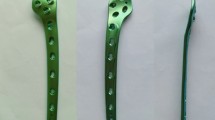Abstract
Introduction
In orthopaedic surgery, small bicortical circular bone defects are often produced as a result of internal fixation of fractures. The aim of this study was to determine the amount of torsional strength reduction in animal bone with a bicortical bone defect and how much residual strength remains if the bicortical bone defect was occluded.
Method
Forty pig femurs were divided into four groups. Group 1 femurs were left intact. Group 2 femurs were given a 4 mm bicortical bone defect. Group 3 were prepared as in Group 2, but occluded with a 4.5 mm cortical screw. Group 4 were prepared as in Group 2, but occluded with plaster of paris. Measurements including the length of the bone, working length of the bone, mid-diaphyseal diameter and cortical thickness were recorded. All specimens were tested until failure under torsional loading. Peak torque at failure and angular deformation were recorded. One-way analysis of variance was used to test the sample groups, with a value of P < 0.05 considered to be statistically significant.
Results
When compared with Group 1, all of the other groups showed a reduction in peak torque at failure point. Only the difference in peak torque between Groups 1 and 2 was statistically significant (P = 0.007). Group 2 showed the most reduction with 23.11% reduction in peak torque and 38.19% reduction in total energy absorption. No significant difference was found comparing the bone length, bone diameter and the cortical thickness.
Conclusion
The presence of the defect remains the major contributing factor in long bone strength reduction. It has been shown that a 10% bicortical defect was sufficient to produce a reduction in peak torque and energy absorption under torsional loading. By occluding this defect using a screw or plaster of paris, an improvement in bone strength was achieved. These results may translate clinically to an increased vulnerability to functional loads immediately following screw removal and prior to the residual screw holes healing.



Similar content being viewed by others
References
Clark CR et al (1977) The effect of biopsy-hole shape and size on bone strength. J Bone Joint Surg Am 59(2):213–217
McBroom RJ, Cheal EJ, Hayes WC (1988) Strength reductions from metastatic cortical defects in long bones. J Orthop Res 6(3):369–378
Rosson J et al (1991) Bone weakness after the removal of plates and screws. Cortical atrophy or screw holes? J Bone Joint Surg Br 73(2):283–286
Evans PE, Thomas WG (1984) Tibial fracture through a traction-pin site. A report of two cases. J Bone Joint Surg Am 66(9):1475–1476
Hidaka S, Gustilo RB (1984) Refracture of bones of the forearm after plate removal. J Bone Joint Surg Am 66(8):1241–1243
Jessop HT, Snell J, Allison JM (1959) The stress concentration factors in cylindrical tubes with transverse circular holes. Aeronaut Q (10):326–344
Chrisman OD, Snook GA (1968) The problem of refracture of the tibia. Clin Orthop Relat Res 60:217–219
Nordon M, Frankel VH (2001) Basic biomechanics of the musculoskeletal system, 3rd edn. Lippincott Williams & Wilkins, pp 27–55
Heimbach D et al (2000) Acoustic and mechanical properties of artificial stones in comparison to natural kidney stones. J Urol 164(2):537–544
Hirasawa T, Nagamitsu T (1976) Comparison between physical properties of resin materials and those of gypsum materials for dental models and dies (author’s transl). Shika Rikogaku Zasshi 17(38):139–144
Brooks DB, Burstein AH, Frankel VH (1970) The biomechanics of torsional fractures. The stress concentration effect of a drill hole. J Bone Joint Surg Am 52(3):507–514
Sammarco GJ et al (1971) The biomechanics of torsional fractures: the effect of loading on ultimate properties. J Biomech 4(2):113–117
Burstein AH, Frankel VH (1971) A standard test for laboratory animal bone. J Biomech 4(2):155–158
Nunamaker DM, Richardson DW, Butterweck DM (1991) Mechanical and biological effects of plate luting. J Orthop Trauma 5(2):138–145
Hipp JA et al (1990) Structural consequences of transcortical holes in long bones loaded in torsion. J Biomech 23(12):1261–1268
Burstein AH et al (1972) Bone strength. The effect of screw holes. J Bone Joint Surg Am 54(6):1143–1156
Frankel VH, Burstein AH (1968) The biomechanics of refracture of bone. Clin Orthop Relat Res 60:221–225
Edgerton BC, An KN, Morrey BF (1990) Torsional strength reduction due to cortical defects in bone. J Orthop Res 8(6):851–855
Burchardt H, Busbee GA 3rd, Enneking WF (1975) Repair of experimental autologous grafts of cortical bone. J Bone Joint Surg Am 57(6):814–819
Remiger AR, Miclau T, Lindsey RW (1997) The torsional strength of bones with residual screw holes from plates with unicortical and bicortical purchase. Clin Biomech Bristol Avon 12(1):71–73
Alford JW et al (2007) Resorbable fillers reduce stress risers from empty screw holes. J Trauma 63(3):647–654
Mousset B et al (1993) Plaster of paris: a carrier for antibiotics in the treatment of bone infections. Acta Orthop Belg 59(3):239–248
Mousset B (1995) Biodegradable implants for potential use in bone infection. An in vitro study of antibiotic-loaded calcium sulphate. Int Orthop 19(3):157–161
Peltier LF et al (1957) The use of plaster of paris to fill defects in bone. Ann Surg 146(1):61–69
Peltier LF, Jones RH (1978) Treatment of unicameral bone cysts by curettage and packing with plaster of paris pellets. J Bone Joint Surg Am 60(6):820–822
Peltier LF (1959) The use of plaster of paris to fill large defects in bone. Am J Surg 97(3):311–315
Acknowledgments
This was a self funding project.
Conflict of interest statement
No financial support of this project has occurred. The author has received nothing of value.
Author information
Authors and Affiliations
Corresponding author
Rights and permissions
About this article
Cite this article
Ho, K.W.K., Gilbody, J., Jameson, T. et al. The effect of 4 mm bicortical drill hole defect on bone strength in a pig femur model. Arch Orthop Trauma Surg 130, 797–802 (2010). https://doi.org/10.1007/s00402-010-1093-4
Received:
Published:
Issue Date:
DOI: https://doi.org/10.1007/s00402-010-1093-4




